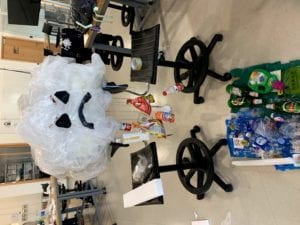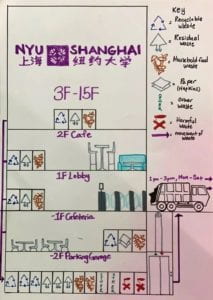Idea
Our art installation aims to remind people that the trash we throw away is not away– “There is no away” according to the idea of “Bag It” documentary. The trash that seems to be disposed of go to stream, ocean, land or even sky. The idea of making a raining-trash cloud comes from the plastic pieces in the sky. That trash that we dispose of, especially plastic have incredible durability that in hundreds of year could they be totally disposed of. It definitely ruins our environment and sacrifices carrying capacity of the future. We want to encourage people to pay attention to the trash they throw away in daily life so as to help them form the sense of trash in life.

Making process:
We mainly use the materials of bubble wrap, plastic bottles, the one-used plastic package for food, wrap for delivery, white foam board, wine glasses bottle and plastic bags. For the cloud part, which I am mainly responsible for, we use a huge cloth bag and many pieces of white foam board to make the body of cloud. Then, we use many bubble wrap to shape the cloud. For the rain, we cut plastic bags into pieces of rope as the tool to tie the plastic bottles and connect them to the cloud. It is really interesting that at first, we decided to make several small holes in the cloud so as to tie the plastic ropes to the cloud, but we found out that it is okay but it might fall down. So we decided to use the tap.
For land and water on the ground, we use different color elements: blue and green. We use all the green trash to represent the ground and all the blue trash to represent the water. We cover all the trash on cardboard so as to make it more stable. For stabilization, we use a glue which was found in the trash by accident.
For the show position, we decide to choose 2f cafe because we think that it is the best place because we can hang our cloud on the top or just on the stairs. But eventually, we just put on a high chair beside the garbage bin.
Reflection:
Generally, I am pretty satisfied with our installation because we make it “artistic” instead of just the combination of many trash pieces. Then we have a really good idea and aim. But I think we can do it matter on some perspectives. Firstly, we didn’t use all the trash we collect in the last two weeks. That is not good to some extent because we throw them away again. Secondly, we use other materials besides what we collect: glues and tapes. For the showing position, it will be much better if we can hang our cloud on the top of the cafe.
Reading Response:
-Collective Responsibilities
In this reading, the key concept that I learn about is that the recycling industry in Shanghai is mainly divided into two parts: the formal sector(government) and informal sector(private trash collectors). In the formal sector, trash mostly go landfill and incinerated. Informal sector consists of much private trash collectors. They go across buildings and street to collect trash and sell them to swapping point or larger-scale recycling center. But those people are ununified and in independent working mode. They are “informal”. The future of the recycling industry in Shanghai should be that government incorporate the informal collectors and formalized them into a rounded industry. There are many business opportunities to unify those individual workers so that to form a formal system. Besides, the government should invest more in the building of incinerators and recycling facilities so as to enhance the ability of trash treatment.
-Sustainability
The most valuable information but not the latest is that the idea of sustainability doesn’t contradict to business. The concept of “sustainability” is not to meet the needs currently without sacrificing the ability to meets the needs of the future. For business, in common sense, it will definitely go against the sustainabilities, which is wrong. But the thing is that we need to come up with sustainable practices.
Trash Map:
In our group, we divide the work into two parts: research and visualization. I choose the visualization part. For research, our group members reached An Ayi who collects trash from classrooms and got the conclusion that all the trash sorted will go to B2, which is the parking garage for our school. Then, our group went to B2 to research more.
The parking garage is organized neatly, which is totally different from my imagination. The garbage bins are in different color: red, green, blue and black. The categories are Kitchen waste(come from cafeteria and cafe as I guess), Harmful waste, recyclable waste and residual waste(from all the garbage bins in AB) and other waste(I am not sure which kind of waste should belong to this category actually).
The trash truck will come to AB every day from 1 pm to 3 pm, except Sunday.
According to the work of research, I got the idea of drawing an AB and highlight the important floors like B1 and B2. Maya drew our map based on my idea and we finally got:

As we can see, we divide AB into 3-15f and floors below 3f. We highlight the b1 and b2 and the trash truck. The text and icon on the right part are the categories of trash sorting.
Leave a Reply